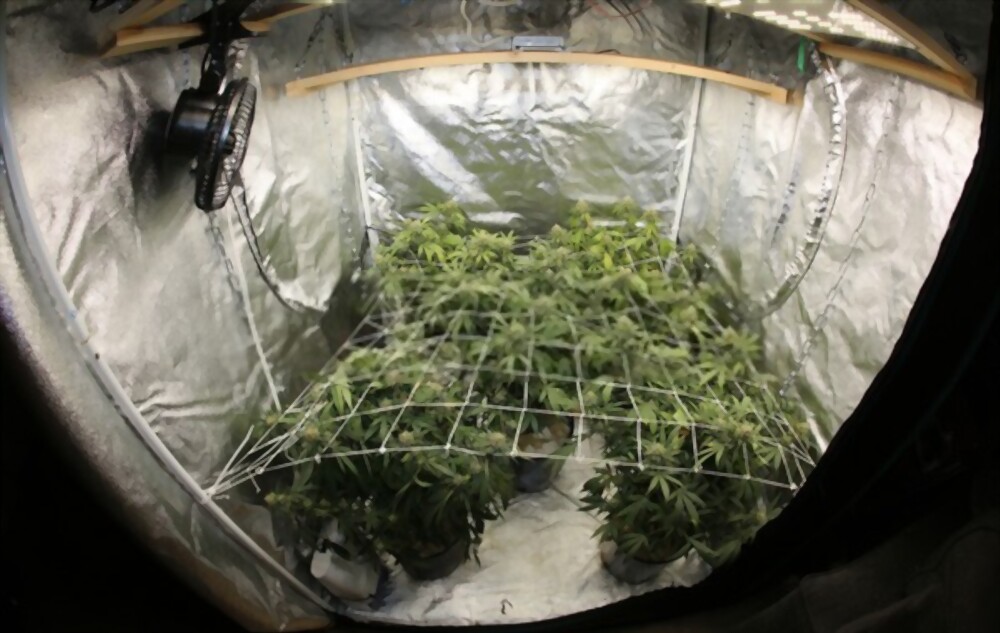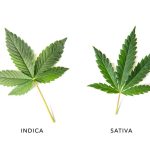🔥 Website for Sale - Contact Us
With many cannabis cultivation techniques available, choosing the right method can be daunting, especially when it comes to plant training techniques.
In this comprehensive guide, we will explore two of the most popular plant training methods in the cannabis world: Screen of Green (ScrOG) and Sea of Green (SOG). Both techniques boast unique benefits and have garnered a loyal grower following. Today we are looking at the benefits, factors to consider, and expert tips to help you choose the best grow technique for your needs.
II. Understanding Screen of Green (ScrOG)
A. Definition and Purpose of ScrOG
Screen of Green, commonly referred to as ScrOG, is a plant training technique that involves using a horizontal screen to guide and support cannabis plant growth. The main purpose of ScrOG is to maximize light exposure to the plants, ensuring that even the lower branches receive ample light.
The ScrOG method is particularly beneficial for growers with limited space, as it encourages plants to grow horizontally rather than vertically. By training the plants to grow through the screen, you can create an even canopy of buds, making the most efficient use of available light. This technique helps prevent the formation of a dominant central cola, which is typical in untrained cannabis plants. Instead, it promotes the development of multiple, equally-sized colas that contribute to a higher yield.
In addition to optimizing light exposure, ScrOG offers better control over plant growth. Carefully pruning can prevent them from becoming too tall, making them easier to manage. ScrOG is also an excellent method for managing plant height in areas with strict height restrictions on cannabis plants.
In summary, the Screen of Green technique is a popular plant training method that allows growers to maximize light exposure, increase yield, and maintain better control over their cannabis plants’ growth.
B. Benefits of ScrOG
The Screen of Green technique has gained popularity among cannabis growers for its numerous advantages. By implementing ScrOG in your garden, you can expect the following benefits:
Maximizes light exposure: The primary goal of ScrOG is to ensure that all parts of the plant receive sufficient light. By creating an even canopy, this method allows for more efficient light distribution, resulting in healthier plants and improved bud development.
Increased yield: With better light distribution and the promotion of multiple colas, ScrOG has the potential to significantly increase your overall yield. Instead of producing one dominant central cola, plants trained using the ScrOG method develop several high-quality colas, contributing to a higher harvest.
Better control over plant growth: ScrOG allows growers to manage the height and shape of their plants more effectively. By training your plants to grow horizontally, you can prevent them from becoming too tall, making them easier to maintain in confined spaces or areas with height restrictions.
Improved airflow and reduced humidity: The even canopy created by the ScrOG method promotes better air circulation around the plants. This helps to prevent the buildup of humidity, reducing the risk of mold and other moisture-related issues.
Efficient use of space: ScrOG is an excellent solution for growers with limited space, as it encourages plants to grow horizontally rather than vertically. This enables you to grow more plants in a smaller area, maximizing your garden’s productivity.
Enhanced potency and quality: By ensuring that all parts of the plant receive ample light, ScrOG promotes the development of more resinous, potent buds. This results in a higher-quality product with improved flavor and aroma profiles.
C. Key Factors to Consider with ScrOG
While the Screen of Green technique offers many advantages, it’s essential to consider certain factors before implementing it in your cannabis garden. Here are some key aspects to keep in mind:
Space requirements: Although ScrOG is an efficient method for utilizing limited space, you still need to provide ample room for your plants to grow horizontally. Ensure that your grow area has enough width to accommodate the horizontal growth facilitated by the ScrOG technique.
Training and pruning: ScrOG requires active involvement in training and pruning your plants. You’ll need to weave the branches through the screen and remove any unnecessary foliage to maintain an even canopy.
Time commitment: The ScrOG method may extend the vegetative growth phase of your plants, as you’ll need to allow them to grow horizontally through the screen before switching to the flowering phase. Be prepared for a longer overall grow cycle compared to some other cultivation techniques.
Screen selection and setup: Choosing the right screen material and size is crucial for the success of your ScrOG setup. Common materials include plastic netting, metal wire, or string. The screen should be strong enough to support the weight of your plants and have holes large enough to accommodate your plants’ branches. Additionally, the screen should be placed at the correct height, usually 20-30 cm (8-12 inches) above the base of the plants to allow for space growth and training.
Strain selection: Some cannabis strains are better suited for ScrOG than others. Indica-dominant strains with short, bushy growth patterns often work well with the ScrOG method. On the other hand, strains with a tall, lanky growth pattern may be more challenging to manage. Research and choose strains that are known to respond well to ScrOG techniques.
III. Understanding Sea of Green (SOG)
A. Definition and Purpose of SOG
The sea of Green method, commonly known as SOG, is another popular plant training technique that focuses on growing many small cannabis plants close together. The primary goal of the SOG method is to create a dense canopy of buds resembling a sea of green.
The SOG technique involves growing plants with a short vegetative growth period, often no more than two to three weeks, before transitioning them into the flowering phase. This results in smaller, more manageable plants that still produce a sizable yield. By growing many plants in close proximity, the canopy created by their collective foliage ensures efficient use of available light, leading to a shorter harvest cycle.
SOG is particularly beneficial for growers looking to maximize their yield per square foot and increase the number of harvests per year.
In summary, the Sea of Green technique is an efficient plant training method that allows growers to maximize yield and harvest their crop quickly by growing many small cannabis plants close together, creating a dense canopy of buds.
B. Benefits of SOG
The Sea of Green technique has become a favorite among cannabis growers for its numerous advantages. By implementing SOG in your garden, you can expect the following benefits:
Faster harvest: SOG significantly shortens the vegetative growth phase of your plants, allowing you to transition them into the flowering phase sooner. This results in a quicker overall grow cycle and allows growers to harvest their crop faster than with many other cultivation methods.
Efficient use of space: By growing many small plants close together, SOG maximizes the use of available space in your garden.
Increased yield per square foot: With the dense canopy created by the closely spaced plants, SOG ensures efficient light exposure and maximizes yield per square foot. Although individual plants may produce smaller buds, the collective yield can be quite impressive.
Reduced risk of pests and diseases: Smaller plants are generally easier to maintain and monitor for pests and diseases. The short vegetative growth period in the SOG method also means that there is less time for pests and diseases to establish themselves in your garden.
Less reliance on plant training: Unlike the ScrOG method, SOG requires minimal plant training, making it a more straightforward approach for beginners or growers with limited time. This also means fewer chances of damaging your plants during the training process.
Suitable for various growing mediums: The SOG method can be used in conjunction with a variety of growing mediums, such as soil, coco coir, or hydroponic systems, offering flexibility to growers with different preferences and setups.
In conclusion, the Sea of Green technique offers numerous benefits, including faster harvest, efficient use of space, increased yield per square foot, and reduced risk of pests and diseases. By implementing SOG in your cannabis garden, you can expect a quality harvest in a shorter amount of time, with minimal effort required for plant training.
C. Key Factors to Consider with SOG
Vegetative growth period: With SOG, the vegetative growth phase is shorter than with most other growing techniques. It’s crucial to monitor your plants closely and switch to the flowering phase at the appropriate time, typically within two to three weeks of growth.
Plant spacing: Proper plant spacing is crucial for the success of your SOG setup. Be sure to provide enough space for each plant to grow and develop without overcrowding, while still maintaining a dense canopy for optimal light exposure.
Strain selection: Some cannabis strains are better suited for SOG than others. Indica-dominant strains with short, bushy growth patterns are typically preferred, as they produce a dense canopy and respond well to the short vegetative growth period.
Cloning or seed selection: SOG often involves using clones from a mother plant to ensure uniform growth and consistency among plants. If you choose to grow from seeds, be sure to select feminized seeds to avoid male plants, which can negatively impact your yield.
IV. Comparing ScrOG and SOG: Factors to Consider
Now that we’ve delved into the intricacies of both Screen of Green (ScrOG) and Sea of Green (SOG) techniques, it’s time to compare the two methods and highlight the factors you should consider when deciding which approach is best for you.
Space requirements: ScrOG focuses on horizontal growth, while SOG emphasizes growing many small plants close together. If you have limited vertical space, ScrOG may be the better choice. On the other hand, if you have limited horizontal space, SOG might be more suitable.
Plant count: SOG typically requires a higher number of plants compared to ScrOG. If you face legal limitations on the number of plants you can grow or prefer to manage fewer plants, ScrOG may be the better option.
Time commitment: ScrOG demands more hands-on involvement in training and pruning your plants, while SOG requires less plant training. If you have limited time or prefer a more straightforward approach, SOG might be the better fit.
Vegetative growth period: SOG has a shorter vegetative growth phase, leading to faster harvests, while ScrOG may extend the vegetative phase to allow for horizontal growth. If you’re looking to harvest quickly, SOG may be the better choice.
Yield distribution: ScrOG promotes multiple equally-sized colas and larger individual buds, while SOG focuses on maximizing yield per square foot with numerous smaller plants. If you prefer a more evenly distributed yield with larger buds, ScrOG could be the better option.
Strain selection: Some cannabis strains are better suited for either ScrOG or SOG techniques. Be sure to research and choose strains that are known to thrive in the environment you wish to create.
Growing experience: If you’re a beginner or have limited experience with plant training, SOG may be the easier option to start with, as it requires less hands-on involvement. However, if you’re willing to dedicate time and effort to training and pruning your plants, ScrOG can offer significant rewards in terms of yield and quality.
By weighing these factors and considering your specific needs, resources, and preferences, you can make an informed decision about which plant training technique, ScrOG or SOG, is the best fit for your cannabis garden. Both methods have their unique benefits and can lead to a bountiful harvest when implemented correctly.
V. Expert Tips for Choosing Between ScrOG and SOG
A. Assessing Your Personal Preferences and Priorities
Before choosing between the Screen of Green (ScrOG) and Sea of Green method (SOG) techniques, it’s crucial to assess your personal preferences and priorities as a cannabis grower. Reflecting on these aspects will help you determine the best method for your unique situation:
Time investment: Consider how much time you’re willing to invest in your cannabis garden. ScrOG demands more hands-on involvement in training and pruning, while SOG requires less plant training. If you have limited time or prefer a more straightforward approach, SOG might be the better fit.
Experience level: Your experience as a grower will influence your ability to implement either method effectively. If you’re a beginner, you may find SOG easier to manage due to its minimal training requirements. However, if you’re an experienced grower, you might enjoy the challenges and rewards of the advanced ScrOG technique.
Space constraints: Analyze your available grow space and determine which method better suits your constraints. If you have limited vertical space, ScrOG may be more appropriate, as it focuses on horizontal growth. Conversely, if you have limited horizontal space, SOG could be a better fit, as it emphasizes growing many small plants close together.
Yield preferences: Consider whether you prefer a more evenly distributed yield with larger buds (ScrOG) or maximizing yield per square foot with numerous smaller plants (SOG). Reflect on your desired outcome and choose the technique that aligns with your preferences.
Legal considerations: Be mindful of any legal restrictions on the number of plants you can grow in your area. If you face limitations on plant count, ScrOG may be the better option, as SOG typically requires a higher number of plants.
By assessing your personal preferences and priorities, you can make an informed decision about which plant training technique, ScrOG or SOG, is the best fit for your cannabis garden. Both methods have their unique benefits and can lead to quality harvest when implemented correctly.
B. Considering Your Local Climate and Growing Conditions
Another essential factor to consider when choosing between Screen of Green (ScrOG) and Sea of Green (SOG) techniques is your local climate and growing conditions. Consider the following factors:
Temperature: Both ScrOG and SOG are adaptable to a wide range of temperature conditions, but strains may be more sensitive to temperature fluctuations than others. When selecting strains for your chosen method, consider the temperature requirements of each strain and how they align with your local climate.
Humidity: ScrOG promotes better airflow and reduced humidity around your plants, which can be advantageous in areas with high humidity or when growing indoors. SOG, with its closely spaced plants, might require more attention to humidity control. Assess the humidity levels in your grow environment and choose the method that best addresses potential humidity-related issues.
Light availability: ScrOG aims to maximize light exposure for all parts of the plant by creating an even canopy, while SOG focuses on optimizing light exposure through a dense canopy of smaller plants. Evaluate the light availability in your growing area, and choose the technique that best utilizes the available light.
Outdoor vs. indoor growing: Both ScrOG and SOG can be used in outdoor and indoor growing environments. However, ScrOG may be more adaptable to various outdoor conditions, as it offers better control over plant height and shape. SOG, on the other hand, might be better suited for controlled indoor environments where growers can maintain optimal conditions for numerous small plants.
Growing medium: Both ScrOG and SOG can be used with different growing mediums, such as soil, coco coir, or hydroponic systems. Consider your preferred growing medium and how it may impact your chosen method, as well as the specific needs of your selected cannabis strains.
By considering your local climate and growing conditions, you can further refine your decision between ScrOG and SOG techniques. By choosing the technique that aligns with your local climate and growing conditions, you can optimize the success of your cannabis garden.
C. Factoring in Legal Restrictions and Regulations
When choosing between Screen of Green (ScrOG) and Sea of Green (SOG) techniques, it’s essential to factor in legal restrictions and regulations that may apply to your cannabis garden. Consider the following when making your decision:
Plant count limitations: Some jurisdictions limit the number of cannabis plants that can be grown legally by individual growers. As SOG typically requires a higher number of plants compared to ScrOG, it’s essential to choose a method that adheres to your local plant count restrictions.
Height restrictions: Certain jurisdictions may impose height restrictions on cannabis plants, especially in residential areas. ScrOG focuses on horizontal growth and allows for better control over plant height, making it a suitable option for complying with height limitations.
Privacy concerns: In some locations, it may be required to keep your cannabis plants out of public view. Both ScrOG and SOG can be adapted for privacy, but ScrOG’s horizontal growth pattern may make it easier to maintain a lower profile when growing outdoors.
Local zoning laws: Some areas may have zoning laws that dictate where cannabis can be grown or restrict certain cultivation techniques. Ensure that your chosen method, whether ScrOG or SOG, is compatible with your local zoning laws.
By factoring in legal restrictions and regulations, you can make a more informed decision when choosing between ScrOG and SOG techniques. It’s crucial to ensure that your cannabis garden remains compliant with local laws to avoid potential legal consequences and enjoy a successful, hassle-free growing experience.
VI. Frequently Asked Questions about ScrOG and SOG
As you consider the Screen of Green (ScrOG) and Sea of Green (SOG) techniques for your cannabis garden, you may have some questions about these methods. Here are some commonly asked questions and their answers:
Can I combine ScrOG and SOG techniques?
While ScrOG and SOG are distinct methods, you can experiment by combining elements of both techniques. For example, you could use a screen to train plants in a Sea of Green setup, allowing for more even light distribution.
Which method is better for beginners?
SOG is generally considered more beginner-friendly due to its minimal plant training requirements and shorter vegetative growth period. However, both techniques can be learned and mastered by beginners with dedication and research.
Can I use ScrOG and SOG for autoflowering strains?
Yes, both ScrOG and SOG techniques can be used with autoflowering strains. However, it’s important to select strains that are well-suited for the chosen method and to adjust your training techniques and timelines to accommodate the unique growth patterns of autoflowering plants.
What is the ideal plant spacing for ScrOG and SOG?
In a ScrOG setup, plant spacing depends on the size of your screen and the desired canopy density. Generally, plants should be spaced 8 to 12 inches apart. For SOG, plants should be spaced closer together, typically 4 to 6 inches apart, to create a dense canopy.
How do I choose the right cannabis strains for my chosen method?
Research and select strains that are known to thrive in either a ScrOG or SOG environment. Indica-dominant strains with short, bushy growth patterns are generally preferred for SOG, while strains with more lateral growth and an even branching structure are better suited for ScrOG.
How can I maximize yield using ScrOG or SOG?
To maximize yield in a ScrOG setup, ensure even light distribution, maintain proper plant spacing, and diligently train your plants to create an even canopy. For SOG, focus on optimizing plant spacing, selecting appropriate strains, and controlling the vegetative growth period to maximize yield per square foot.
By understanding the answers to these frequently asked questions, you’ll be better equipped to make an informed decision about which plant training technique, ScrOG or SOG, is the best fit for your cannabis garden. Remember that both methods have their unique benefits and challenges, and with proper research and implementation, you can achieve a bountiful harvest using either technique.
VIII. Conclusion
Screen of Green (ScrOG) and Sea of Green (SOG) are two popular plant training techniques used in cannabis cultivation, each with its unique benefits and challenges.
ScrOG focuses on horizontal growth and promoting multiple colas, which can lead to a more evenly distributed yield with larger buds. In contrast, SOG emphasizes growing many small plants close together to maximize yield per square foot. Both techniques can be adapted to different strains, environments, and grower preferences.
With proper implementation and attention to detail, both ScrOG and SOG can lead to a quality harvest that aligns with your specific needs and goals.





